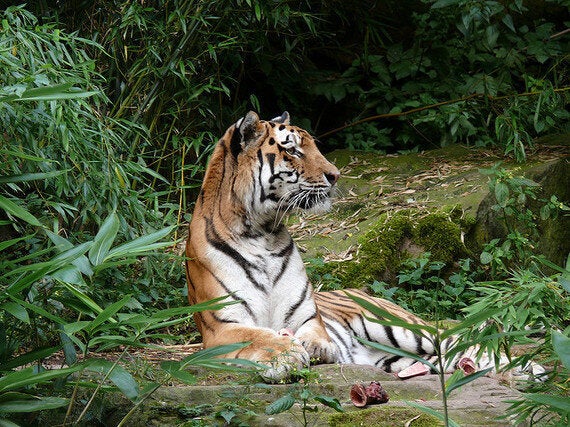
Last week sprouted the news that for the first time in 100 years, tiger numbers worldwide are on the rise. After a century of poaching and loss of habitat, the world's Tigers are starting to claw their way back into prosperity.
Roughly half of the estimated total of nearly 4,000 wild tigers live in India, where they are held in reverence and respect by the human population. Their long standing traditional history, in many countries including India, hasn't helped them survive however.
Poaching and trophy hunting, as with many other large animals, has been devastating to the world's tigers, pushing their number down into the low thousands. Prized for their pelts and paws as trophies, Tigers have been illegally killed, exported, traded and sold for years. Threatened too by demand for various vital organs that are, you guessed it, used in traditional Chinese medicine, Tigers have been on the brink for decades. Once again, little to no evidence suggests that these remedies that use illegal animal substances actually work, but the demand continues to grow and the populations continue to wither.
This brutal decline in numbers has only been accelerated by ever declining habitat too. Unfortunately for the tiger, they are native to some of the world's most rapidly expanding countries. India particularly, but also other countries of South East Asia too are home to most of the world's tigers, meaning that they're own habitats are threatened by the need to expand our own.
Being such an iconic animal, Tigers have had the unwavering backing of a number of international conservation organisations, WWF being one of them. WWF's aim is to have double tiger populations by the year 2022. This seems like a somewhat out of reach target, given that the population has increased by only one fifth since 2010.

So what's actually being done? What does that big impressive word 'conservation' actually mean in practical terms?
Starting in India, it means cordoning off vast areas of land for national park and reserves. Closely monitored areas like this are common worldwide now as they ensure a far more controlled environment for the animals to live in. In India, these sorts of reserves are manned around the clock, monitoring both the borders and the animals within to help prevent poachers getting anywhere near them.
Sticking with India at the moment, news recently points to the country planning to relocate a small number of tigers to Cambodia, just over the way. This is in an effort to further increase the global population by allowing more land and more habitats for the tigers to prowl around in.
The house moving plans aren't just in India however, Russia are jumping on the bandwagon.
Furthering this idea of expanding the population, Russia has plans to move some of their native amur and Siberian tigers to the steppes of Kazakhstan. That area of central Asia has not had any tiger populations since the extinction of the Caspian Tiger in the 1970's. Tigers are already the biggest of the big cats, but this Caspian subspecies were the biggest of the big.

Relocations such as these are one thing. It's all very well and good relocating animals in the hope that they will flourish in their new home. However, the risk is then run that they will eventually start to suffer the same slings and arrows as their ancestors did in their original home. Is moving the animals not just moving the problem?
A number of countries in that region have outlawed hunting and selling of tigers. As with many other animal products, tiger pelts, paws and whatever else are all illegal to see and trade. This law system is being credited somewhat with the increased numbers, but it's not enough yet.
What must be remembered with the tiger population is the sheer diversity of landscapes in which they live. In the case of lions or cheetahs, their habitats are vast open plains that are far easier to traverse than hilly tropics or mountain ranges like where the tiger lives. This makes any one form of conservation difficult and causes a demand for a combined effort.
That combined effort is national parks and patrols, adoption or sponsorship, volunteering, scientific research and strict laws and penalties for the hunting and illegal trade. It seems like a big task, but this week's news of the increased population is proof that these methods are working. Keep it up.
If you want to be more hands on, follow this link to the Frontier Tiger Conservation Projects.
By Guy Bezant - Online Journalism Intern
Frontier runs conservation, development, teaching and adventure travel projects in over 50 countries worldwide - so join us and explore the world!
See more from our volunteers #Frontiervolunteer
